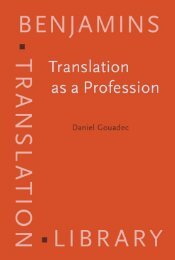Constructing a Sociology of Translation.pdf
Constructing a Sociology of Translation.pdf
Constructing a Sociology of Translation.pdf
- No tags were found...
Create successful ePaper yourself
Turn your PDF publications into a flip-book with our unique Google optimized e-Paper software.
9Johan Heilbron and Gisèle Sapirotion itself, from a “hermeneutic movement” (Steiner 1975: 296–303) that aimsat gaining access to the “meaning” <strong>of</strong> the text and to its uniqueness. By contrast,cultural studies, in accordance with a relativist conception, insist on the variousmodes <strong>of</strong> appropriating texts, on the instability <strong>of</strong> their meaning, and on the mutualpermeability <strong>of</strong> cultures. Both kinds <strong>of</strong> analyses, however, set aside the socialconditions <strong>of</strong> the interpretative act, which amounts to ignoring the plurality <strong>of</strong>implicated agents, as well as the effective functions that translations might fulfil,both for the translator and for various mediators, as well as for the readerships intheir historical and social spaces <strong>of</strong> reception.The economic approach, more powerful socially but much less widespreadwithin studies on translation, performs a reduction that is somewhat the contrary.In opposition to the obsession with a text’s singularity and the uniqueness <strong>of</strong> itsauthor, the economic approach assimilates translated books into the most generalcategory <strong>of</strong> goods, identifying them as merchandise produced, distributed andconsumed according to the logic <strong>of</strong> national and international markets. But toconsider translated books as commodities like any other occults the specificity <strong>of</strong>cultural goods as well as the modalities specific to their production and marketing.The market <strong>of</strong> symbolic goods is a specific type <strong>of</strong> economy that functionsaccording to its own criteria <strong>of</strong> valuation (Bourdieu 1977, 1993).Breaking with both these reductive and opposite approaches, a proper sociologicalanalysis embraces the whole set <strong>of</strong> social relations within which translationsare produced and circulated. In this respect, it is closely affiliated to two relatedresearch areas developed by comparativists, historians <strong>of</strong> literature and specialistsin cultural and intellectual history: translation studies, and studies <strong>of</strong> culturaltransfer. Appearing in the 1970s in small and <strong>of</strong>ten multilingual countries (Israel,Belgium, Netherlands), translation studies managed to displace the problematic.Rather than analysing translation solely or principally in relation to an original,whether source-text or source-language, or inversely, encompassing them in thevague notion <strong>of</strong> cultural hybridization, as happens in Cultural Studies, this newresearch domain was interested in questions about the functioning <strong>of</strong> translationsin their contexts <strong>of</strong> production and reception, that is to say, in the target culture(Holmes, Lambert and Lefevere 1978; Even-Zohar 1990; Toury 1995). The question<strong>of</strong> the relation between the contexts <strong>of</strong> production and reception also underpinsthe historical study <strong>of</strong> “cultural transfers”, which investigates the role <strong>of</strong> theagents in these exchanges, both institutions and individuals, and their inscriptionin the political and cultural relations between the countries involved (Espagneand Werner 1990–1994). The development <strong>of</strong> comparative cultural history hasgiven rise to reflection and debate on a suitable way <strong>of</strong> articulating a comparativeapproach with the analysis <strong>of</strong> transfers (Charle 1996; Espagne 1999: 35–49).
















